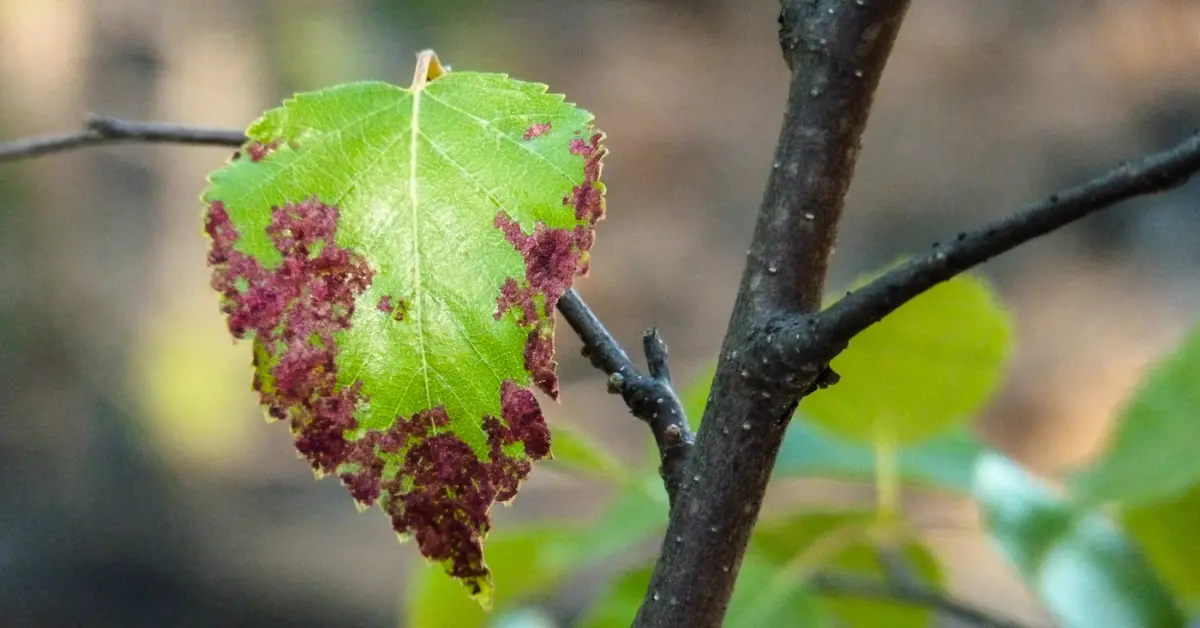As living organisms, trees are also susceptible to disease. And while trees may not catch a cold or get the flu, their diseases can also be deadly. Because trees can’t speak, can’t show signs of pain, and struggle to communicate, many people may not even recognize that the tree in their own yard could be diseased. And that isn’t a good thing—a dying or dead tree can be a serious safety hazard and potentially damage a home.
Here are four of the most common tree diseases in North Texas as well as a few visible signs or symptoms that can help you recognize when your tree might be suffering from one.
Leaf Blight
Leaf blight is a disease that gets its name from the fact that it almost exclusively impacts tree leaves, particularly on fruit-producing trees. This disease is rampant in North Texas because conditions here are about as good as they can be to encourage its spread—rainy and humid conditions encourage its development, while high winds and water aid in spread. When warm temperatures combine with wetness, such as in the springtime, the disease grows rapidly.
Leaf blight can be extremely hard to distinguish, particularly on younger plants or trees with sensitive leaves. This is because leaf blight is often mistaken for burn marks on leaves. However, these brown patches are not sun scald. Instead, they are typically a type of fungus that prevents the leaf from maximizing photosynthesis, thus making it frail, feeble, and weak. Eventually, leaves turn brown, curl up, and die. Should the disease spread too far, the whole tree itself could die from a lack of sunlight and carbon dioxide.
Oak Wilt
Oak wilt is reaching epidemic proportions in the state of Texas. This disease almost exclusively impacts oak trees—one of the most common types of tree found throughout North Texas. Once again, this disease is caused by a parasitic fungus that invades the tree and disables its water conducting system. Eventually, the tree dies of thirst. Any species of oak is susceptible, but red oaks appear to be the highest risk of any type found in our community.
Oak wilt typically appears in the leaves on a tree. While it isn’t strange for leaves to fall from a tree, it is strange for them to be half-brown or half-dead when they do fall. If the stems on your leaves appear to be green, but the extremities are dehydrated and crunchy, and this phenomenon occurs at times other than the fall or early winter, then your oak tree may very well be suffering from oak wilt.
Powdery Mildew
Powdery mildew gets its name from the fact that it shows up in the form of white mildew that looks a lot like baby powder. The powdery substance is actually millions and millions of tiny fungal spores that the mildew fungus itself produces while infecting the leaves on one of your trees. This powder slowly causes a decline in a tree’s vigor, leading to yellowing or browning leaves, premature leaf drop, and leaf distortion. Eventually, this problem can lead to a tree dying.
Powdery mildew is an annoying problem because it’s so hard to get rid of. Initial outbreaks typically occur because of spores riding wind currents into your yard. However, once established, spores can go dormant in your soil. When think the problem is gone, the spores can sprout, reinfecting any new trees or plants in the area. However, the good news for North Texas is that this problem isn’t common in areas with a lot of sunlight, rain, or high temperatures. Therefore, you will really only ever see this issue on trees in shady areas or on leaves that are buried well within a tree canopy.
Anthracnose
Anthracnose is a disease known to target deciduous trees, including oak, sycamore, ash, and several other families of trees found throughout North Texas. This disease often looks a lot like leaf blight, with brown patches appearing on leaves. However, Anthracnose will also create holes along leaf veins, creating leaves that can resemble Swiss cheese at times.
Much like a few of the other diseases listed here, this is also a fungal disease. This is also a particularly nasty disease for trees to deal with, as it has a tendency to attack the tips of young twigs. These tips are generally vulnerable, and when they die any leaves or buds that may have developed on them will die alongside them. This prevents a tree from foliating, and in turn can result in the tree dying.
Do you suspect you have a diseased or dying tree? If you’re seeing signs of poor tree health, get help from Purple Care today! Give our specialists a call at (817) 880-6052.




Comments (0)
Thanks for your comment!
Thanks for your feedback! Your comments have been successfully submitted! Please note, all comments require admin approval prior to display.
Error submitting comment!
There is a problem with your comment, please see below and try again.